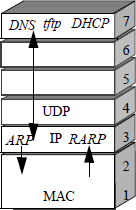Chapter 9
Address Resolution and Automatic Configuration Protocols

The previous chapter explained how equivalent entities can exchange information using the IP protocol. This chapter will explain the way the addresses are translated from one layer to another. The protocols ARP, RARP, BOOTP, DHCP and DNS are presented.
This chapter also introduces the TFTP protocol. Although it does not serve to show the correspondence between two address levels, it is used at the station initialization.
9.1. Introduction
Address resolution is a complex problem. It goes from one representation used at one level to that used in another. Each level has an optimized representation based on the treatment it has to assure. So:
— The local networks prefer the automatic configuration allocating an address from the network card manufacturer. The user does not have to worry about address allocation. The uniqueness of the address is guaranteed, but by instance the station location is difficult and is not scalable.
— The Internet encourages stations’ localization to the detriment of the address allocation facility. The addresses are structured to help the localization of the station in the network, but the allocation must be done manually. In IPv4, protocols such as DHCP (see section 9.4.4) can be used to facilitate address allocation, but the addresses’ server must be configured, which transfers the configuration ...
Get Local Networks and the Internet: From Protocols to Interconnection now with the O’Reilly learning platform.
O’Reilly members experience books, live events, courses curated by job role, and more from O’Reilly and nearly 200 top publishers.

